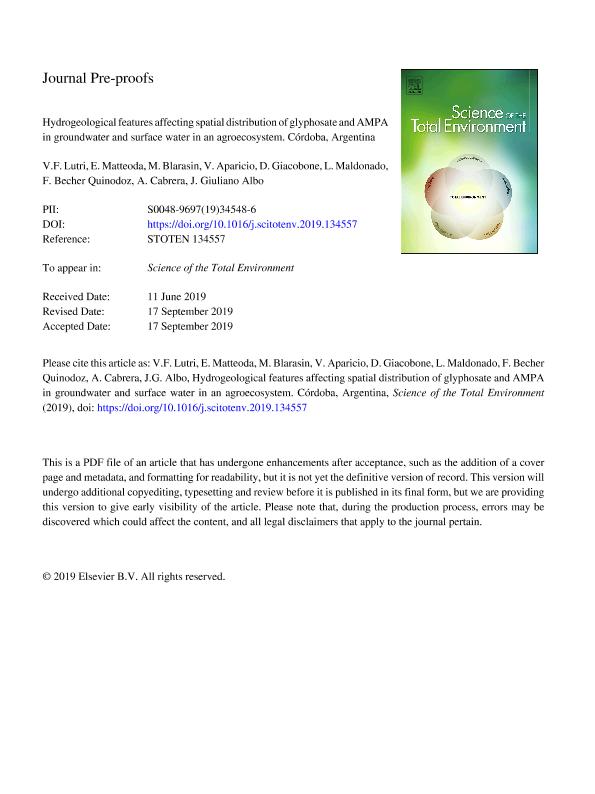Mostrar el registro sencillo del ítem
dc.contributor.author
Lutri, Veronica Florencia

dc.contributor.author
Matteoda, Edel Mara

dc.contributor.author
Blarasin, Mónica Teresa

dc.contributor.author
Aparicio, Virginia Carolina

dc.contributor.author
Giacobone, Daniela Beatriz

dc.contributor.author
Maldonado, Luciana
dc.contributor.author
Bécher Quinodóz, Fátima Noelia

dc.contributor.author
Cabrera, Adriana Edith

dc.contributor.author
Giuliano Albo, María Jesica

dc.date.available
2021-04-09T20:13:21Z
dc.date.issued
2020-04-01
dc.identifier.citation
Lutri, Veronica Florencia; Matteoda, Edel Mara; Blarasin, Mónica Teresa; Aparicio, Virginia Carolina; Giacobone, Daniela Beatriz; et al.; Hydrogeological features affecting spatial distribution of glyphosate and AMPA in groundwater and surface water in an agroecosystem. Córdoba, Argentina; Elsevier Science; Science of the Total Environment; 711; 134557; 1-4-2020; 1-51
dc.identifier.issn
0048-9697
dc.identifier.uri
http://hdl.handle.net/11336/129754
dc.description.abstract
The study area is located in the eastern slope of Las Peñas Mountain and its adjacent oriental fluvio-aeolian-plain. Agriculture is the main activity (soybean, maize, wheat, peanuts and alfalfa) with no-tillage farming and intensive use of agrochemicals (pesticides-fertilizers). Glyphosate (N-phosphono-methylglycine) is the most common used herbicide which suffers microbial biodegradation giving aminomethylphosphonic acid (AMPA), its main metabolite. The objective of this work is to evaluate hydrogeological features which influence the presence of glyphosate and AMPA in waters. In the study area, the main flow direction of surface and groundwater is NW-SE. The unsaturated zone thickness decreases in the same direction from 60 to 0 m, so groundwater surges in low areas in the eastern sector. From the total water samples collected, glyphosate was detected in 66% of surface water samples (0.2 to 167.4 μg/L), in 15.8% of the groundwater samples (1.3 to 2 μg/L) and in the harvested precipitation sample (0.2 μg/L). AMPA was found in 33% of surface water and 15.8% of groundwater. The herbicide detection was related to areas with the shallowest water table (< 4 m), low hydraulic conductivity in the aquifer (K = 1.5 m/d), low hydraulic gradient (i = 0.16%) and very low flow velocity (0.02 m/d). The most outstanding result is that the groundwater presents higher values in comparison with the surface water samples, which can be explained by the greater dilution capacity of streams. The detection of glyphosate and AMPA in the unconfined aquifer shows that the application for decades under the prevailing agricultural model exceeds the degradation potential of the soil and the unsaturated zone, causing groundwater contamination.
dc.format
application/pdf
dc.language.iso
eng
dc.publisher
Elsevier Science

dc.rights
info:eu-repo/semantics/openAccess
dc.rights.uri
https://creativecommons.org/licenses/by-nc-sa/2.5/ar/
dc.subject
CÓRDOBA (ARGENTINA)
dc.subject
GLYPHOSATE-AMPA
dc.subject
GROUNDWATER POLLUTION
dc.subject
HYDROGEOLOGICAL FEATURES
dc.subject.classification
Oceanografía, Hidrología, Recursos Hídricos

dc.subject.classification
Ciencias de la Tierra y relacionadas con el Medio Ambiente

dc.subject.classification
CIENCIAS NATURALES Y EXACTAS

dc.title
Hydrogeological features affecting spatial distribution of glyphosate and AMPA in groundwater and surface water in an agroecosystem. Córdoba, Argentina
dc.type
info:eu-repo/semantics/article
dc.type
info:ar-repo/semantics/artículo
dc.type
info:eu-repo/semantics/publishedVersion
dc.date.updated
2021-03-25T13:42:17Z
dc.journal.volume
711
dc.journal.number
134557
dc.journal.pagination
1-51
dc.journal.pais
Países Bajos

dc.journal.ciudad
Amsterdam
dc.description.fil
Fil: Lutri, Veronica Florencia. Universidad Nacional de Río Cuarto. Facultad de Ciencias Exactas, Fisicoquímicas y Naturales. Departamento de Geología; Argentina. Consejo Nacional de Investigaciones Científicas y Técnicas. Centro Científico Tecnológico Conicet - Córdoba; Argentina
dc.description.fil
Fil: Matteoda, Edel Mara. Consejo Nacional de Investigaciones Científicas y Técnicas. Centro Científico Tecnológico Conicet - Córdoba; Argentina
dc.description.fil
Fil: Blarasin, Mónica Teresa. Consejo Nacional de Investigaciones Científicas y Técnicas. Centro Científico Tecnológico Conicet - Córdoba; Argentina
dc.description.fil
Fil: Aparicio, Virginia Carolina. Consejo Nacional de Investigaciones Cientificas y Tecnicas. Centro Cientifico Tecnologico Conicet - Mar del Plata. Instituto de Innovación Para la Producción Agropecuaria y El Desarrollo Sostenible. - Instituto Nacional de Tecnologia Agropecuaria. Centro Regional Buenos Aires Sur. Estacion Experimental Agropecuaria Balcarce. Instituto de Innovación Para la Producción Agropecuaria y El Desarrollo Sostenible.; Argentina
dc.description.fil
Fil: Giacobone, Daniela Beatriz. Universidad Nacional de Río Cuarto. Facultad de Ciencias Exactas, Fisicoquímicas y Naturales. Departamento de Geología; Argentina. Consejo Nacional de Investigaciones Científicas y Técnicas. Centro Científico Tecnológico Conicet - Córdoba; Argentina
dc.description.fil
Fil: Maldonado, Luciana. Consejo Nacional de Investigaciones Científicas y Técnicas. Centro Científico Tecnológico Conicet - Córdoba; Argentina
dc.description.fil
Fil: Bécher Quinodóz, Fátima Noelia. Consejo Nacional de Investigaciones Científicas y Técnicas. Centro Científico Tecnológico Conicet - Córdoba; Argentina
dc.description.fil
Fil: Cabrera, Adriana Edith. Consejo Nacional de Investigaciones Científicas y Técnicas. Centro Científico Tecnológico Conicet - Córdoba; Argentina
dc.description.fil
Fil: Giuliano Albo, María Jesica. Consejo Nacional de Investigaciones Científicas y Técnicas. Centro Científico Tecnológico Conicet - Córdoba; Argentina
dc.journal.title
Science of the Total Environment

dc.relation.alternativeid
info:eu-repo/semantics/altIdentifier/doi/http://dx.doi.org/10.1016/j.scitotenv.2019.134557
dc.relation.alternativeid
info:eu-repo/semantics/altIdentifier/url/https://www.sciencedirect.com/science/article/abs/pii/S0048969719345486
Archivos asociados
